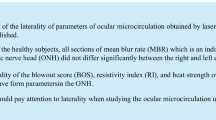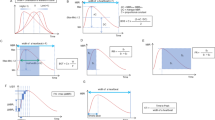Abstract
Purpose
To evaluate and compare the temporal changes in pulse waveform parameters of ocular blood flow (OBF) between non-habitual and habitual groups due to caffeine intake.
Method
This study was conducted on 19 healthy subjects (non-habitual 8; habitual 11), non-smoking and between 21 and 30 years of age. Using laser speckle flowgraphy (LSFG), three areas of optical nerve head were analyzed which are vessel, tissue, and overall, each with ten pulse waveform parameters, namely mean blur rate (MBR), fluctuation, skew, blowout score (BOS), blowout time (BOT), rising rate, falling rate, flow acceleration index (FAI), acceleration time index (ATI), and resistive index (RI). Two-way mixed ANOVA was used to determine the difference between every two groups where p < 0.05 is considered significant.
Result
There were significant differences between the two groups in several ocular pulse waveform parameters, namely MBR (overall, vessel, tissue), BOT (overall), rising rate (overall), and falling rate (vessel), all with p < 0.05. In addition, the ocular pulse waveform parameters, i.e., MBR (overall), skew (tissue), and BOT (tissue) showed significant temporal changes within the non-habitual group, but not within the habitual group. The temporal changes in parameters MBR (vessel, tissue), skew (overall, vessel), BOT (overall, vessel), rising rate (overall), falling rate (overall, vessel), and FAI (tissue) were significant for both groups (habitual and non-habitual) in response to caffeine intake.
Conclusion
The experiment results demonstrated caffeine does modulate OBF significantly and response differently in non-habitual and habitual groups. Among all ten parameters, MBR and BOT were identified as the suitable biomarkers to differentiate between the two groups.







Similar content being viewed by others
References
McLellan TM, Caldwell JA, Lieberman HR (2016) A review of caffeine’s effects on cognitive, physical and occupational performance. Neurosci Biobehav Rev 71:294–312. https://doi.org/10.1016/j.neubiorev.2016.09.001
Okuno T, Sugiyama T, Tominaga M, Kojima S, Ikeda T (2002) Effects of caffeine on microcirculation of the human ocular fundus. Jpn J Ophthalmol 46(2):170–176
Terai N, Spoerl E, Pillunat LE, Stodtmeister R (2012) The effect of caffeine on retinal vessel diameter in young healthy subjects. Acta Ophthalmol 90(7):e524–e528. https://doi.org/10.1111/j.1755-3768.2012.02486.x
Kennedy DO, Haskell CF (2011) Cerebral blood flow and behavioural effects of caffeine in habitual and non-habitual consumers of caffeine: a near infrared spectroscopy study. Biol Psychol 86(3):298–306. https://doi.org/10.1016/j.biopsycho.2010.12.010
Sugiyama T, Araie M, Riva CE, Schmetterer L, Orgul S (2010) Use of laser speckle flowgraphy in ocular blood flow research. Acta Ophthalmol 88(7):723–729. https://doi.org/10.1111/j.1755-3768.2009.01586.x
Sato T, Sugawara J, Aizawa N, Iwama N, Takahashi F, Nakamura-Kurakata M, Saito M, Sugiyama T, Kunikata H, Nakazawa T, Yaegashi N (2017) Longitudinal changes of ocular blood flow using laser speckle flowgraphy during normal pregnancy. PLoS One 12(3):e0173127. https://doi.org/10.1371/journal.pone.0173127
Zimmermann-Viehoff F, Thayer J, Koenig J, Herrmann C, Weber CS, Deter HC (2016) Short-term effects of espresso coffee on heart rate variability and blood pressure in habitual and non-habitual coffee consumers—a randomized crossover study. Nutr Neurosci 19(4):169–175. https://doi.org/10.1179/1476830515Y.0000000018
Bell DG, McLellan TM (2002) Exercise endurance 1, 3, and 6 h after caffeine ingestion in caffeine users and nonusers. J Appl Physiol 93(4):1227–1234. https://doi.org/10.1152/japplphysiol.00187.2002
Portella Rde L, Barcelos RP, da Rosa EJ, Ribeiro EE, da Cruz IB, Suleiman L, Soares FA (2013) Guarana (Paullinia cupana Kunth) effects on LDL oxidation in elderly people: an in vitro and in vivo study. Lipids Health Dis 12:12. https://doi.org/10.1186/1476-511X-12-12
Aizawa N, Yokoyama Y, Chiba N, Omodaka K, Yasuda M, Otomo T, Nakamura M, Fuse N, Nakazawa T (2011) Reproducibility of retinal circulation measurements obtained using laser speckle flowgraphy-NAVI in patients with glaucoma. Clin Ophthalmol 5:1171–1176. https://doi.org/10.2147/OPTH.S22093
Luft N, Wozniak PA, Aschinger GC, Fondi K, Bata AM, Werkmeister RM, Schmidl D, Witkowska KJ, Bolz M, Garhofer G, Schmetterer L (2016) Ocular blood flow measurements in healthy white subjects using laser speckle flowgraphy. PLoS One 11(12):e0168190. https://doi.org/10.1371/journal.pone.0168190
Fukami M, Iwase T, Yamamoto K, Kaneko H, Yasuda S, Terasaki H (2017) Changes in retinal microcirculation after intravitreal ranibizumab injection in eyes with macular edema secondary to branch retinal vein occlusion. Invest Ophthalmol Vis Sci 58(2):1246–1255. https://doi.org/10.1167/iovs.16-21115
Laerd S (2015) Two-way mixed ANOVA using SPSS statistics. Statistical tutorials and software guides. https://statistics.laerd.com/premium/spss/twma/two-way-mixed-anova-in-spss-24.php. Accessed 8 Jan 2018
Tsuda S, Kunikata H, Shimura M, Aizawa N, Omodaka K, Shiga Y, Yasuda M, Yokoyama Y, Nakazawa T (2014) Pulse-waveform analysis of normal population using laser speckle flowgraphy. Curr Eye Res 39(12):1207–1215. https://doi.org/10.3109/02713683.2014.905608
Enaida H, Nagata S, Takeda A, Nakao S, Ikeda Y, Ishibashi T (2016) Changes in chorioretinal blood flow velocity and cerebral blood flow after carotid endarterectomy. Jpn J Ophthalmol 60(6):459–465. https://doi.org/10.1007/s10384-016-0472-y
Bettermann K, Slocomb J, Shivkumar V, Quillen D, Gardner TW, Lott ME (2017) Impaired retinal vasoreactivity: an early marker of stroke risk in diabetes. J Neuroimaging : Official J Am Soc Neuroimaging 27(1):78–84. https://doi.org/10.1111/jon.12412
Addicott MA, Yang LL, Peiffer AM, Burnett LR, Burdette JH, Chen MY, Hayasaka S, Kraft RA, Maldjian JA, Laurienti PJ (2009) The effect of daily caffeine use on cerebral blood flow: how much caffeine can we tolerate? Hum Brain Mapp 30(10):3102–3114. https://doi.org/10.1002/hbm.20732
Meredith SE, Juliano LM, Hughes JR, Griffiths RR (2013) Caffeine use disorder: a comprehensive review and research agenda. J Caffeine Res 3(3):114–130. https://doi.org/10.1089/jcr.2013.0016
Yanagida K, Iwase T, Yamamoto K, Ra E, Kaneko H, Murotani K, Matsui S, Terasaki H (2015) Sex-related differences in ocular blood flow of healthy subjects using laser speckle flowgraphy. Invest Ophthalmol Vis Sci 56(8):4880–4890. https://doi.org/10.1167/iovs.15-16567
Chandrasekaran S, Rochtchina E, Mitchell P (2005) Effects of caffeine on intraocular pressure: the Blue Mountains Eye Study. J Glaucoma 14(6):504–507
Pemp B, Georgopoulos M, Vass C, Fuchsjager-Mayrl G, Luksch A, Rainer G, Schmetterer L (2009) Diurnal fluctuation of ocular blood flow parameters in patients with primary open-angle glaucoma and healthy subjects. Br J Ophthalmol 93(4):486–491. https://doi.org/10.1136/bjo.2008.148676
Fukami M, Iwase T, Yamamoto K, Ra E, Murotani K, Terasaki H (2017) Diurnal variation of pulse waveform parameters determined by laser speckle flowgraphy on the optic nerve head in healthy subjects. Medicine 96(44):e8312. https://doi.org/10.1097/MD.0000000000008312
Iwase T, Yamamoto K, Ra E, Murotani K, Matsui S, Terasaki H (2015) Diurnal variations in blood flow at optic nerve head and choroid in healthy eyes: diurnal variations in blood flow. Medicine 94(6):e519. https://doi.org/10.1097/MD.0000000000000519
Panza JA, Epstein SE, Quyyumi AA (1991) Circadian variation in vascular tone and its relation to alpha-sympathetic vasoconstrictor activity. N Engl J Med 325(14):986–990. https://doi.org/10.1056/NEJM199110033251402
Funding
The project was funded by the Ministry of Higher Education Malaysia under HICoE scheme to CISIR. The sponsor had no role in the design or conduct of the research.
Author information
Authors and Affiliations
Corresponding author
Ethics declarations
Conflict of interest
The authors declare that they have no conflict of interest.
Ethical approval
All procedures performed in studies involving human participants were in accordance with the ethical standards of the institutional research committee and with the 1964 Helsinki declaration and its later amendments or comparable ethical standards.
Informed consent
Informed consent was obtained from all individual participants included in the study.
Electronic supplementary material
ESM 1
(DOCX 28.7 kb)
Rights and permissions
About this article
Cite this article
Ismail, A., Bhatti, M.S., Faye, I. et al. Pulse waveform analysis on temporal changes in ocular blood flow due to caffeine intake: a comparative study between habitual and non-habitual groups. Graefes Arch Clin Exp Ophthalmol 256, 1711–1721 (2018). https://doi.org/10.1007/s00417-018-4030-9
Received:
Revised:
Accepted:
Published:
Issue Date:
DOI: https://doi.org/10.1007/s00417-018-4030-9




